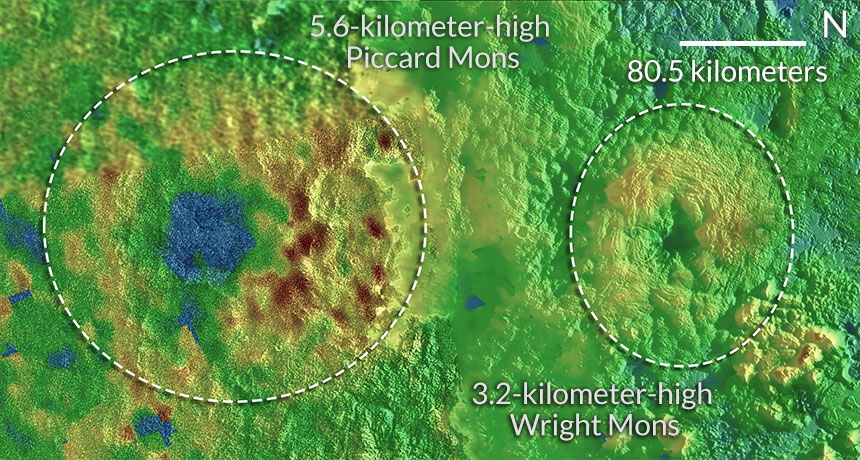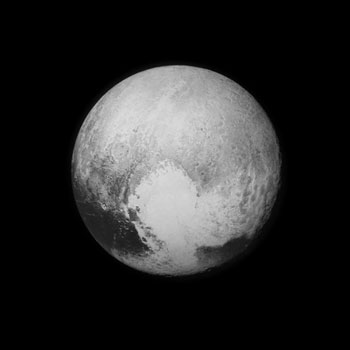Weird Pluto gives up its secrets
New Horizons mission to Pluto shows dramatically varied terrain and gravity-defying moons

The New Horizons spacecraft has provided data that allow scientists to map details of Pluto’s surface. In this topographical map of two ice volcanoes, lower elevations are shown in blue and higher elevations are shown in brown.
SWRI, JHUAPL, NASA
OXON HILL, Md. — At this point, the only thing unsurprising about Pluto is that it continues to offer up surprises.
Pluto is a weirder place than scientists had ever imagined. It has widely different landscapes, a family of wildly spinning moons and volcano-like mountains that spew ice instead of rock. Those surprises are among the many that NASA’s New Horizons mission uncovered this year. Its scientists reported their findings in November at a meeting of the American Astronomical Society’s planetary sciences division.
The Pluto mission is offering scientists rich lessons, said Alan Stern. He led the program to get a spacecraft to Pluto. “It’s going to take the larger planetary science community many years to digest all this,” he noted at a news briefing.
Even though Pluto is part of the solar system, it’s so far away that scientists had known little about what it might be like. That changed in 2015.
A long voyage
The New Horizons spacecraft was launched in 2006. It’s taken almost a decade for it to reach Pluto’s neighborhood. On July 14, the spacecraft finally buzzed the dwarf planet and started sending back data. It has so far sent back only about 20 percent of the data it obtained from the Pluto system. And every new nugget confirms that Pluto is a riddle.
Terrains both new and old sit side-by-side on Pluto’s surface. Some heavily cratered regions are roughly 4 billion years old, about as old as Pluto itself. Others appear to have been laid down recently — within the last 10 million years — judging by their total lack of craters.

Other dramatic landscapes also have been coming into focus. That’s because images streaming in over the past few months have let researchers create maps in great detail that show natural features of the landscape, such as hills and valleys. These are called topographical (TOW-poh-GRAF-ih-kul) maps. One crack in Pluto’s surface is 320 kilometers long. Its walls are roughly 4 kilometers high. (That’s about twice the depth of the Grand Canyon!)
Two mountains look strangely similar to shield volcanoes back on Earth. Shield volcanoes are a type of large volcano with gently sloping sides. They get their name from the fact that they look like a warrior’s shield lying on the ground. On Pluto, though, these volcanoes would spew ice, not rock. “There’s nothing like this seen in the outer solar system,” says Oliver White. He’s a planetary scientist at the NASA Ames Research Center in Moffett Field, Calif. Researchers aren’t certain that the mountains are volcanoes, but they also don’t know what else to call them. “Whatever they are, they’re definitely weird,” says White.
A layer of gases — an atmosphere — surrounds Pluto. These gases are much colder and more compact than researchers had thought. That means the atmosphere is probably escaping into space much more slowly than predicted.
Among other unusual features
Calculations before New Horizons arrived on the scene suggested that the ice level on Pluto’s crust had dropped by nearly 1 kilometer over the dwarf planet’s lifetime. That would have occurred as its ice turned directly into gas and then drifted into space. But at the current escape rate, the dwarf planet would have knocked only about 15 centimeters (6 inches) off of its icy crust. “It’s dangerous to go from a snapshot to 4.5 billion years [Pluto’s lifetime],” cautions Leslie Young. She is a planetary scientist at the Southwest Research Institute in Boulder, Colo. “But we’re scientists,” she says. “That’s what we do.”
SPIN ME ROUND This animation shows the orbits of Pluto’s moons Charon, Nix, Styx, Kerberos and Hydra (from closest to farthest). Data from the New Horizons mission show the four outermost moons spin faster than scientists ever expected. SWRI, JHUAPL, NASA |
Far above Pluto whirl four tiny moons. They, too, are behaving unexpectedly. The satellites’ names are Nix, Hydra, Kerberos and Styx. Pluto’s gravity should have slammed on the brakes and slowed down their spins. But the rapidly twirling moons seem not to have gotten gravity’s instructions.
Hydra, the outermost moon, whips around its axis about 89 times during each orbit around Pluto and its largest moon, Charon. Nix, meanwhile, appears to be flipped nearly upside down. The other three tiny moons might be spinning on their sides. “We’ve never seen anything like this before, and we still don’t know what to make of it,” says planetary scientist Mark Showalter. He works for the SETI Institute in Mountain View, Calif. He led the team that discovered Kerberos in 2011 and Styx in 2012.
Lots more data are yet to come. They should include very detailed images. If the first 20 percent of the data are any clue, Pluto is probably not done surprising scientists.
Many early predictions about Pluto have proved to be mistakes. “Pluto and its system of satellites really outsmarted us,” says Stern. “I think it’s fair to say that New Horizons gets an ‘A’ for exploration … but we get an ‘F’ for predictive ability.”
Power Words
(for more about Power Words, click here)
atmosphere The envelope of gases surrounding Earth or another planet.
crater A large, bowl-shaped cavity in the ground or on the surface of a planet or the moon. They are typically caused by an explosion or the impact of a meteorite or other celestial body.
dwarf planet One of the solar system’s small celestial objects. Like a true planet, it orbits the sun. However, dwarf planets are too small to qualify as true planets. Prime examples of these objects: Pluto and Ceres.
National Aeronautics and Space Administration Created in 1958, this U.S. agency has become a leader in space research and in stimulating public interest in space exploration. It was through NASA that the United States sent people into orbit and ultimately to the moon. It has also sent research craft to study planets and other celestial objects in our solar system, including Pluto.
planetary science The science of other planets besides Earth.
Pluto A dwarf planet that is located in the Kuiper Belt, just beyond Neptune. Pluto is the tenth largest object orbiting the sun.
satellite A moon orbiting a planet or a vehicle or other manufactured object that orbits some celestial body in space.
SETI An abbreviation for search for extraterrestrial life, meaning life on other worlds.
shield volcano A type of large volcano that has a low profile, like a warrior’s shield lying on the ground. Shield volcanoes are caused by flows of magma.
solar system The eight major planets and their moons in orbit around the sun, together with smaller bodies in the form of dwarf planets, asteroids, meteoroids and comets.
terrain The land in a particular area and whatever covers it. The term might refer to anything from a smooth, flat and dry landscape to a mountainous region covered with boulders, bogs and forest cover.
topographical map A map that shows details of bumps and valleys in a planet’s landscape. A topographical map shows relief features, meaning that it conveys information about elevation changes from one spot on the map to another.
volcano A place on Earth’s crust that opens, allowing magma and gases to spew out from underground reservoirs of molten material. The magma rises through a system of pipes or channels, sometimes spending time in chambers where it bubbles with gas and undergoes chemical transformations. This plumbing system can become more complex over time. This can result in a change, over time, to the chemical composition of the lava as well. The surface around a volcano’s opening can grow into a mound or cone shape as successive eruptions send more lava onto the surface, where it cools into hard rock.







